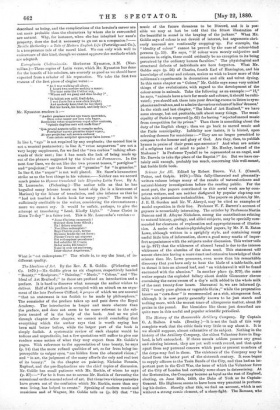Science for All. Edited by Robert Brown. Vol. I. (Cassell,
Potter, and Galpin. 1879.)—This fully-illustrated and pleasantly. written volume brings many of the results of 'natural-science and natural-history investigations before the reading public. For the most part, the papers contributed to this serial work are by com- petent writers, and are neither disfigured by popular clap-trap nor laden with pretentious technicalities. The papers on physics, by Mr. J. E. H. Gordon and Mr. W. Aluoyd, may be cited as examples of model exposition in their line. Professor W. F. Barrett's account of geysers is remarkably interesting. The articles by Professors Martin Duncan and H. Alleyne Nicholson, among the contributions relating to natural history, geology, and allied subjects, may be specially com- mended for clearness of explanation and appropriateness of illustra- tion. A series of chemico-physiological papers, by Mr. F. R. Eaton Lowe, although written in a sprightly style, and containing many useful little bits of information, shows a good many marks of imper- fect acquaintance with the subjects under discussion. This writer tells us (p. 277) that the whiteness of alumed bread is due to the intense whiteness of the alumina of the alum used. This statement will amuse chemists having a more exact and extensive knowledge of their science than Mr. Lowe possesses, even more than his remarkable discovery that you have only to heat the blade of a table-knife, and to thrust it into an alumed loaf, and "on withdrawal it will be found encrusted with the alumina." In another place (p. 373), the same writer repeats the exploded fallacy about double Gloucester cheese containing the extra'cream of a- day's milk added to the whole milk of the next twenty-four hours. Maccaroni is, we are informed (p. 372) "nearly pure gluten or vegetable fibrin ;" while the preparation known as " corn-flour " is recommended as a rich, nitrogenous food, although it is now pretty generally known to be just starch and nothing more, with the merest trace of nitrogenous matter, about 20 grains in the pound. But blemishes like those just described are quite rare in this useful and popular scientific periodical.


































 Previous page
Previous page